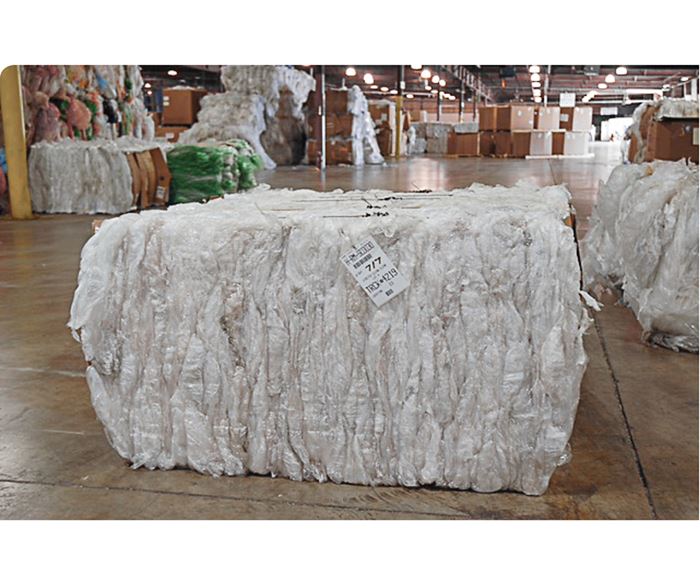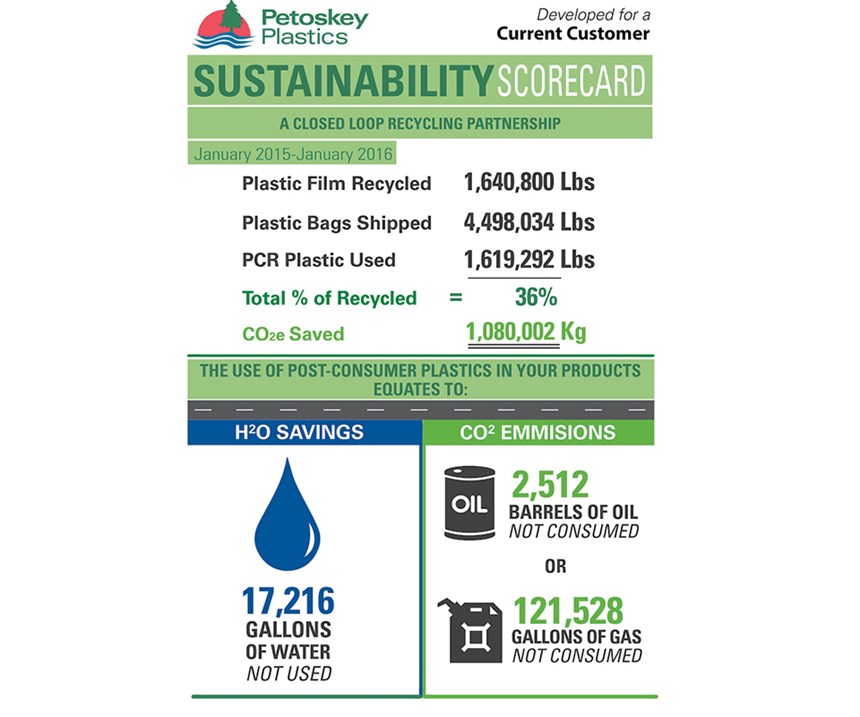Chasing the Perfect Pellet
Petoskey Plastics began recycling in 1978 and continues to expand its green footprint by offering pellets specifically for thin-gauge blown film.
For Petoskey Plastics Inc., Petoskey, Mich., it began on April 1, 1970 with one machine that converted purchased film into bags. Soon thereafter, Petoskey added an extrusion line to manufacture its own film, and over the next several years the firm continued to grow and acquire additional extrusion lines. During all of this, Petoskey Plastics developed experience in manufacturing and using recycled resins. The company’s recycling journey officially began when it first started in-house recycling.
“We’ve been recycling since 1978,” says Jason Keiswetter, Petoskey Plastics’ executive dir. of marketing, research, and development. “This is a part of who we are.”
Fast-forward to the 1990s: The company really began to ramp up its recycling efforts when it was awarded a grant from the state of Michigan through the Quality of Life Bond Fund to recycle post-consumer polyethylene waste. Fifty-percent matching funds were provided, enabling Petoskey Plastics to purchase a recycling line from Italy to reprocess plastic scrap. The recycle department was further expanded with wash-line technology to reprocess post-consumer bags and film in 1991 with a State of Michigan assistance through a Quality of Life Grant.
In 1999, Petoskey Plastics acquired the assets of a polyethylene film plant in Morristown, Tenn. The Morristown plant today has multiple extrusion lines utilizing recycled materials, along with converting lines and a four-color offset paper printing press.
Then in 2007, the company completed renovations to a former garage-door manufacturing facility in Hartford City, Ind., converting the building to a 330,000 ft² recycling plant. In 2013, the company added blown-film manufacturing and converting lines at the Indiana plant. The Petoskey plant in Michigan features numerous extrusion lines utilizing recycled materials originating from the firm’s Indiana recycling facility.
Currently, the company collects and reprocesses approximately 30 million lb/yr and about 30% of its overall production is dedicated to recycling. “Almost 90% of that material is used in our own blown-film extrusion process and the rest is sold to other processors of film and similarly based plastic products,” Keiswetter said. “Our pellet is designed for thin-gauge blown film applications and we are continually improving the quality of our product.”
At the end of 2015, Petoskey announced it would expand its recycling operations in Hartford City, due to a 10-yr tax abatement from the Hartford Council and a $5.4 million investment, marking the third expansion for the company in Hartford City. Keiswetter said the expansion is due to the response to the growth in its recycling services.
The most recent expansion will include refurbishing vacant buildings on the plant property, adding storage and sorting capacity for post-consumer materials coming into the plant, and adding one extrusion line. Petoskey will also make improvements to existing lines that manufacture products using post-consumer recycled (PCR) resin. The expansion is expected to be completed this year and will create six new jobs. Petoskey currently employs about 115.
“Growth in recycling and green products remains strong, and this expansion enhances our capacity to meet that demand,” says company president Paul Keiswetter (father of Jason). “One of the things that weighed on our decision to purchase the Hartford City facility in 2007 was the potential for ongoing expansion. Now, with higher volumes of post-consumer plastic flowing from major national retailers and other sources, that decision is paying off.”
Most of the firm’s blown-film equipment utilizes three-layer technology, though Petoskey also operates multiple five-layer lines. Petoskey is manufacturing converter-grade films utilizing high levels of recycle content. Jason Keiswetter says the company is “more than pleased with the quality and performance of these films.”
He adds that the company continues to invest in new equipment. “We are looking at anything that will get us close to a cleaner pellet that is closer to prime,” he says. “We are chasing this perfect post-consumer pellet.”
Petoskey offers closed-loop programs to help customers divert landfill-bound waste into reusable products like resin or bags and film. It manufactures post-consumer plastic resin (called GreenPE) in Hartford City. Products made with GreenPE resin include the Greencore product lines of industrial and institutional can liners and recycling bags made with up to 70% PCR.
SUSTAINABILITY SCORECARD
Earlier this year, Petoskey introduced a recycling scorecard for customers that purchase products made with its recycled blown film. Working with sustainability consultants, Petoskey developed a system of calculating the impact its closed-loop recycling partners are having on the environment. The company is measuring and providing documentation to its customers for free on landfill diversion, carbon-footprint equivalents, emission offsets, and water savings. The data is based on the level of recycled content in film and bags purchased from Petoskey.
Jason Keiswetter believes this is a first in blown film. “Sustainability scorecards are not new, but they are typically more focused on internal sustainability practices such as recycling or energy-saving measures,” he says. “This is the first robust, proactive effort we have seen that is specifically targeted at customers purchasing products with recycled content. Moreover, the reporting highlights their involvement in a closed-loop recycling program.” Petoskey is offering the program to its recycling partners in retail,distribution, shipping, automotive, and other market sectors.
The scorecard is based on a Life Cycle Analysis (LCA) approach to measuring sustainable practices. Typically, LCA measures energy use, raw-materials consumption, air emissions, water effluents, and solid wastes along the entire life cycle of a production system—from the initial extraction of natural resources to the final disposal of wastes. The company says its scorecard is unique in that it calculates pounds of carbon emissions saved in purchasing plastic film products with PCR content.
“The feedback we have been receiving has been outstanding,” Jason Keiswetter notes. “Our customers are thrilled to see how they have been reducing their carbon footprint.”
While the recycling market is facing economic challenges, Jason Keiswetter is confident about the business: “With new PE capacity coming on stream, we’ll see competitive pricing from prime materials. This will drive down the recycle prices and in turn the appeal to collect and recycle. Those who are solely focused on recycling for profit will have challenges. Companies who are recycling as part of their business strategy or corporate culture and who are vertically integrated under one roof—sourcing of scrap, recycling, pelletizing, and extruding finished goods—will be in the best position to support their partners throughout the next several years of pricing volatility.
“Companies like Petoskey will help their customers avoid landfill costs and increase sustainability efforts through the collection of landfill-bound plastics and the purchasing of products containing recycle content.”
Related Content
The Importance of Melt & Mold Temperature
Molders should realize how significantly process conditions can influence the final properties of the part.
Read MoreTunnel Gates for Mold Designers, Part 1
Of all the gate types, tunnel gates are the most misunderstood. Here’s what you need to know to choose the best design for your application.
Read MoreSolve Four Common Problems in PET Stretch-Blow Molding
Here’s a quick guide to fixing four nettlesome problems in processing PET bottles.
Read MoreHow to Get Rid of Bubbles in Injection Molding
First find out if they are the result of trapped gas or a vacuum void. Then follow these steps to get rid of them.
Read MoreRead Next
Processor Turns to AI to Help Keep Machines Humming
At captive processor McConkey, a new generation of artificial intelligence models, highlighted by ChatGPT, is helping it wade through the shortage of skilled labor and keep its production lines churning out good parts.
Read MoreLead the Conversation, Change the Conversation
Coverage of single-use plastics can be both misleading and demoralizing. Here are 10 tips for changing the perception of the plastics industry at your company and in your community.
Read MoreAdvanced Recycling: Beyond Pyrolysis
Consumer-product brand owners increasingly see advanced chemical recycling as a necessary complement to mechanical recycling if they are to meet ambitious goals for a circular economy in the next decade. Dozens of technology providers are developing new technologies to overcome the limitations of existing pyrolysis methods and to commercialize various alternative approaches to chemical recycling of plastics.
Read More










.png;maxWidth=300;quality=90)






















